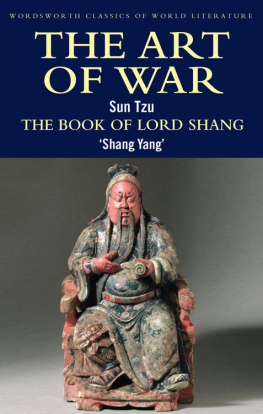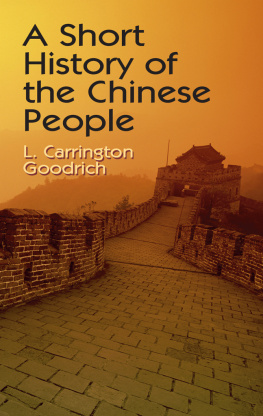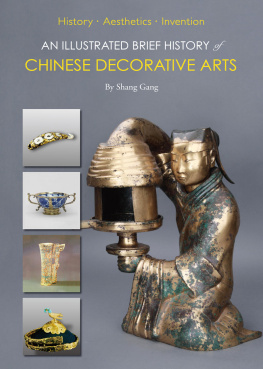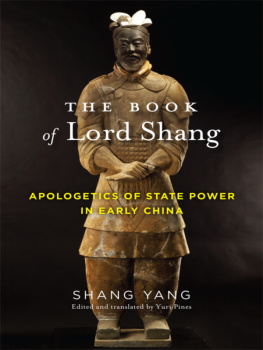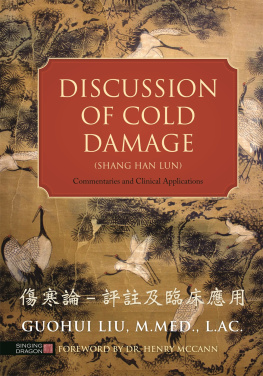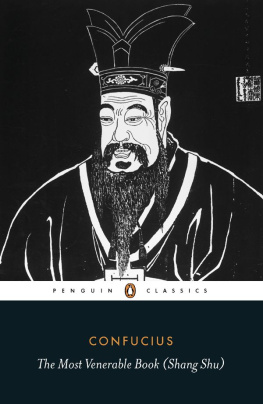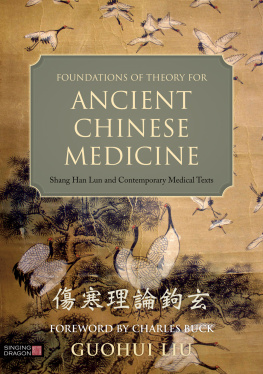Sun Tzu
The Art of War
with a Commentary by
General Tao Hanzhang
Translated by Yuan Shibing
Introduction by Robert Wilkinson
The Book of Lord Shang
Translated by J. J. L. Duyvendak
Introduction by Robert Wilkinson

WORDSWORTH CLASSICS
OF WORLD LITERATURE
The Art of War and The Book of Lord Shang first
published by Wordsworth Editions Limited in 1998 Published as an ePublication 2013 ISBN 978 1 84870 501 2
Introduction Robert Wilkinson 1998
Wordsworth Editions Limited
8B East Street, Ware, Hertfordshire SG12 9HJ Wordsworth is a registered trademark of
Wordsworth Editions Limited Wordsworth Editions is
the company founded in 1987 by
MICHAEL TRAYLER All rights reserved. This publication may not be reproduced, distributed, or transmitted in any form or by any means, or stored in a database or retrieval system, without the prior written permission of the publishers. Readers interested in other titles from Wordsworth Editions are invited to visit our website at
www.wordsworth-editions.com For our latest list of printed books, and a full mail-order service contact Bibliophile Books, Unit 5 Datapoint,
South Crescent, London E16 4TL
Tel: +44 020 74 74 24 74
Fax: +44 020 74 74 85 89
orders@bibliophilebooks.com
www.bibliophilebooks.com
For my husband
ANTHONY JOHN RANSON
with love from your wife, the publisher
Eternally grateful for your
unconditional love
Prefatory Note
Two systems for the romanisation of Chinese are currently in use in the western English-speaking world. One is of western origin the Wade-Giles system and the other, more recent and introduced by the Chinese themselves, called pinyin. Some translations of Chinese works use one system and some the other, making cross-reference occasionally confusing for non-specialists. To offset this difficulty, the following convention has been used in the introductions in this book: Chinese terms are given in their Wade-Giles version, but at their first occurrence the pinyin equivalent is given in square brackets immediately after the Wade-Giles version. For example, the name of the great Chinese historian of the first century BC is given as Ssu-ma Chien [Sima Qian] and his work as Shi Chi [ Shiji ] ( Historical Records ). In about one third of cases, the two systems give the same romanisation. In these instances only one form appears at the first occurrence of the term concerned.
Most of the translators extensive footnotes to The Book of Lord Shang, which deal almost exclusively with matters of textual corruption and variant readings, have been omitted. Scholars interested in these matters should consult the original edition of this work: London, Probsthain 1928.
The Art of War
Introduction
The two Chinese political classics in this book are the product of a time of intense turmoil in Chinese history. The first, Sun Tzus The Art of War the best-known of a considerable body of Chinese works on the subject is concerned to analyse the nature of war and to show how victory can be assured; the second, The Book of Lord Shang, is a political treatise for the instruction of rulers. Its principal aim is to show how a strong state can be created and maintained, a state strong enough to resist its rivals and ultimately gain dominion over them. These texts are the exact reverse of ivory-tower speculations or armchair strategy: they are serious, urgent and practical responses to the desperate conditions prevailing at the time when they were written. They have both been immensely influential in China, and in the case of Sun Tzu in particular, outside it also. As so often, Chinese thought is shown by them to have its roots deep in reality in the widest sense of the term; and they are both again not unusually for major Chinese works characterised by a holistic response to the human predicament. Even amid the military recommendations of Sun Tzu and the political nostrums attributed to Lord Shang, Chinese spirituality in its Taoist form is never far distant. This same philosophy, which has as its goal a transforming personal encounter with ultimate reality, can and does inform every aspect of life, from the practices of the monk to the martial arts. We will return to this point, where appropriate, as we go along. To be unaware of it is to miss the deeper levels of meaning in these works.
As is often the case with the early masterpieces of Chinese thought, the date of composition and the authorship of Sun Tzus The Art of War ( Sun-tzu ping fa [ Sunzi bingfa ]) are not straightforward matters. There is a short biography of Sun Tzu in the greatest of early Chinese historical works, the Historical Records (Shi Chi [ Shiji ]) of Ssu-ma Chien [Sima Qian] (1st century BC ). Here Sun is described as a native of Chi [Qi] who secured service with Ho-lu [Helu], King of Wu, impressing the latter with his military skill. If this were accurate, it would follow that Sun lived around 500 BC , towards the end of the Spring and Autumn period (771481 BC ) in Chinese history. There is good reason to believe, however, that this date is incorrect (it has been the subject of scholarly dispute in China since at least the eleventh century AD ). The reasons for this doubt are partly the absence of corroborative references to Sun in the appropriate major works of the Spring and Autumn period, and partly that the assumptions concerning war made in The Art of War do not reflect the conditions of the earlier time. Whoever wrote this text could assume the existence of large armies with professional officers, which would not have been the case during the Spring and Autumn period. At that time, war was a small-scale, amateurish, chaotic and brief form of self-indulgent adventuring on the part of rulers rather than the serious, professional business envisaged in this text. It is now thought likely that this text was composed during the Warring States period of Chinese history (403221 BC ). It bears the imprint of a single mind, and whoever its author was clearly had direct experience of war. I will continue to refer to the author as Sun Tzu, since this is both convenient and the usage sanctioned by tradition, but in the knowledge that the real authorship of the text is a mystery.
The Warring States period is aptly named. During the two and a quarter centuries of its duration, China as a unified state did not exist. By the end of the preceding Spring and Autumn period, itself marked by regular wars, what was finally to become China consisted of seven powerful and fifteen less powerful states. As its name suggests, the Warring States period was one in which the more powerful autonomous states vied with each other for dominance, swallowing up their smaller neighbours as necessary. The history of the period is accordingly one of constant warfare, alliance and counter-alliance, of treaties made and broken. Unsurprisingly, the nature of war itself changed as the period wore on. As it became clear that political stability could not be achieved easily, war ceased to be adventuring and became a desperately serious matter. The size of armies grew; campaigns became more protracted; the economic burden of maintaining the state in a condition to support an armed conflict became a subject of concern, and again unsurprisingly there emerged a class of professional officers who devoted their lives to the successful conduct of war. As the opening remark of The Art of War puts it without exaggeration war had become the most serious business of the state, the key to survival or ruin. It was a condition for survival that the state had an efficient army well commanded, and it is probable that the author of The Art of War was drawn from this class of professional fighters. In this text, he sums up the fruit of his experience, and in thirteen short chapters tells us how to win.
Next page
